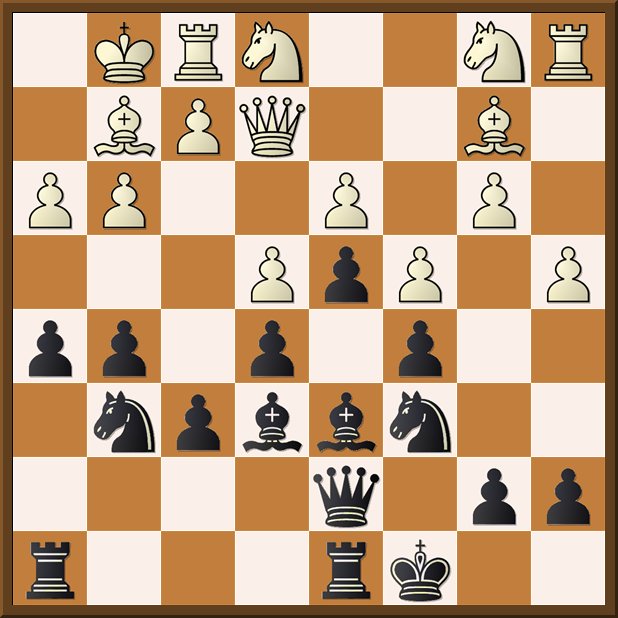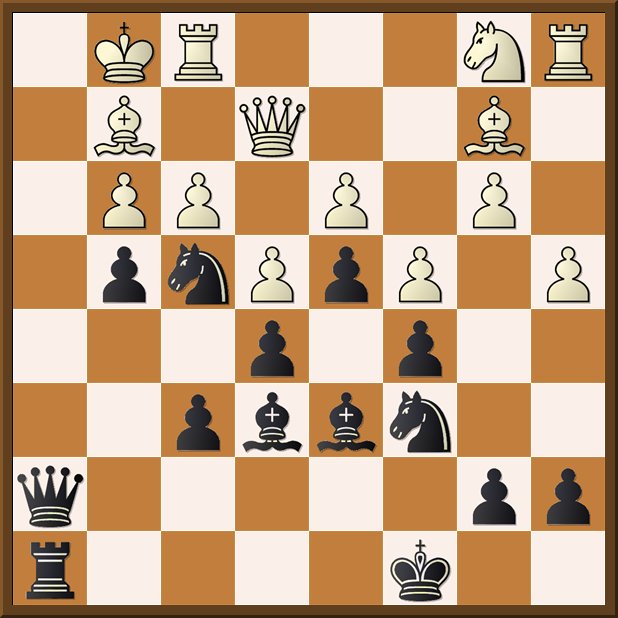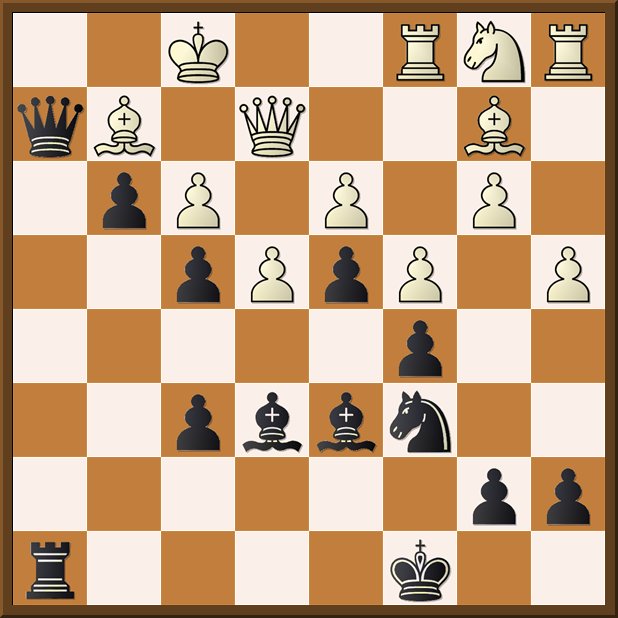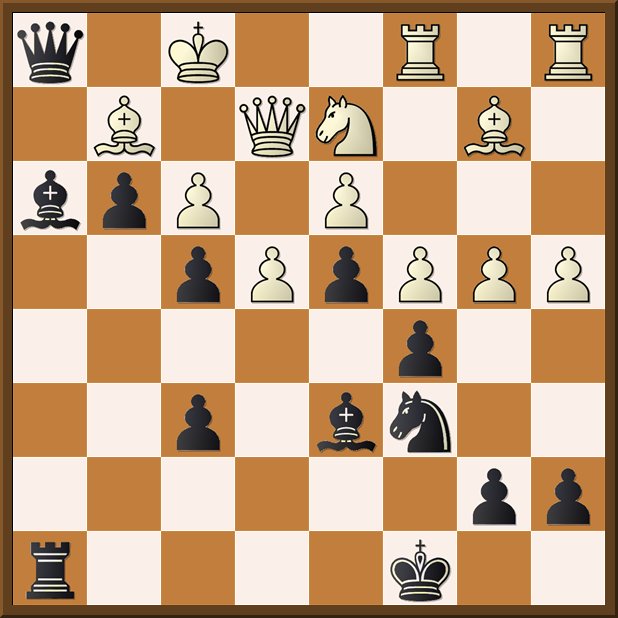All
the |
(Navigation bar
directly below.)
*******
© A.J. Goldsby, 2015.
(All rights reserved.)
****************
Click HERE
to see my
Chess Items.
****************
****************
Buy a book
from Amazon.com
(And help me out as well!)
****************
Click HERE
...
to see a list of the businesses that help to sponsor all of
my chess efforts.
|
|
|
Click HERE to see an explanation of the symbols that I commonly use when I annotate any chess game. Click HERE to replay this game. Click HERE to see my video channel on the "You-Tube" channel. (Click HERE to see my YT video on this game.)
DHARMA_1971 (1748) -
FLchessplayer
(1896)
|
|
|
2kr3r/pp1q4/2nbbpn1/2p1p1pp/P1PpP3/1P1P2PP/1B2QPB1/RN2NRK1 w - - 0 15
Black has developed all of his pieces, while his opponent, while having moved most of his pieces, has a much poorer development and also less space.
White's next move is just bad.
(If I had wanted it, I could have just taken a Pawn on h3,
Nf3? also "walks into" the line-opening pawn advance of ...g5-g4; here.)
15.Nf3? g4; (Viva la audace!)
Played to open lines as quickly as possible, the computer recommends that Black play >/= 15...BxP/h3; here.
16.hxg4 hxg4; 17.Nh2 Rxh2!;
Once more, I played this move rapidly, the idea being to open lines and expose the WK in an expeditious manner.
Here I only saw
17...Qh7; 18.NxP/g4, and now 18...BxN/g4; does not work,
because White responds with 19.QxN/g4+, which is a check.
(This was about all the calculation that I had
time for, even this took too long, at least ten seconds here.)
[ The best line was probably:
>/= RR
17...Qh7!;
18.Nxg4[],
18...Rdg8!;
"/+"
with continuing complications. ( - Fritz 13.)
---> The computer analysis of this position proves that Black will have an overwhelming attack.
(Of course, I had neither the time nor the calculating ability to analyze
these variations to their logical end.) ]
18.Kxh2 Qh7+; 19.Kg1 Rh8;
Very simple and direct ...
and logical as well.
(Black occupies the only open file with a battery, and also threatens a mate on the very
next move here.)
Fritz 13 prefers >/= 19...Nf4!; while the strong chess engine Houdini 1.5 likes RR 19...Kb8!?
Now best (for White) was Re1 or Rd1. <So says the mighty metal monster.>
20.f3 Nf4!!; (thematic)
Not being able to calculate like a machine, I depend a lot on things like experience and also intuition to play bullet chess.
|
|
2k4r/pp5q/2nbbp2/2p1p3/P1PpPnp1/1P1P1PP1/1B2Q1B1/RN3RK1 w - - 0 21
Black's last move is designed to try and take away any lines of escape from the White King ... in an effort to press on with my attack.
[
The following line is (probably) best for Black, perhaps I could have found this
continuation in slow chess, but it would almost be impossible at the current time limit:
>/= RR 20...Qh2+!; 21.Kf2 Rh3!;
This is not a difficult move to find if you have plenty of time on your clock, but I
think it would
be hard to spot in a game of on-minute.
22.Ke1 Rxg3;
23.Rh1[],
("Box.")
Most of the engines agree that this move was forced for White.
(Worse is: </= 23.Rf2? Nf4; "-+" when Black is winning easily. )
23...Qxg2;
24.Qxg2 Rxg2;
25.Bc1 gxf3;
"-/+"
Both Fritz and Houdini agree that White is quite lost here. ]
21.gxf4 g3!; (Fixing squares.)
My last move took away f2 as a flight square from the WK, so ... (once more); I threaten a mate on the move.
22.Rc1 Qh2+; 23.Kf1 exf4;
Now have a look at the current position.
|
|
2k4r/pp6/2nbbp2/2p5/P1PpPp2/1P1P1Pp1/1B2Q1Bq/RNR2K2 w - - 0 24
Black is down a Rook!, but has ample compensation, owing to the danger that the White King is in and also that White's pieces also do not {currently} have any real or meaningful play.
*********************************************************************************************
Now the engines agree that White should have played Na3 here, his next move - although quite natural - is clearly inferior.
24.Nd2!? Bh3; (Pin + restriction.)
My last move contained a powerful threat, now (at last!) my opponent slowed down and thought for at least 20-30 seconds.
25.b4??, (Just a blunder.)
This move loses instantly ...
although the engines all agree that White is clearly lost here.
(See the analysis ... just below.)
[
Fritz gives the following variation, (which I also checked with Houdini); as being clearly forced here:
>/= 25.Bxh3+[] Qxh3+;
26.Qg2[],
Once more, this was forced.
( </= 26.Ke1? Qh1+; 27.Qf1 g2; "-/+" )
26...Qxg2+;
27.Kxg2 Rh2+;
28.Kg1 Rxd2;
29.Rab1 Ne5;
30.Rf1,
(Forced!)
Once more, White has no real choice here.
( But not: </= 30.Rd1? Nxf3+; "-/+" and mate next move. )
30...Rxd3;
31.Kg2 Rxb3;
32.Ba1 Ra3;
33.Bb2 Rxa4;
"-/+"
Black has a Knight and FOUR!!!! Pawns ... for the lost exchange.
(And it appears that the button on c4 here is doomed, as well.) ]
25...Qh1#. (It is over.)
Black used a little calculation here, but depended mostly on things like general principles and rules of thumb to play this particular game.
|
|
2k4r/pp6/2nb1p2/2p5/PPPpPp2/3P1Ppb/1B1NQ1B1/R1R2K1q w - - 0 26
I literally had less than five seconds
left on my clock at the end of this particular encounter.
(I was quite pleased with my overall conduct of this game. Although the analysis
clearly proves that the computer can improve on my play,
I felt that I gave my opponent plenty to think about and set nearly insoluble
problems ... and even sacrificed material, as well.)
Copyright (c) A.J. Goldsby, 2012. All rights reserved.
0 - 1
The analysis for this page was prepared with the excellent program, ChessBase 10.0. (I now have ChessBase 11.0; I also used MANY different chess engines!)
The HTML was polished with several different tools and programs, (mostly FP) ... the text was checked for spelling with MS Word.
|
Go ... or return ... to my Home Page for this site. Go (or return) ... to my "Annotated Games" (II) Page. Go
... or return ... to my "Best
Games" Page. *******
Copyright (c)
LM A.J. Goldsby
I ******* This
page was first generated in: November, 2012. Final
format / posting on: Sunday; November 11th, 2012. . |




